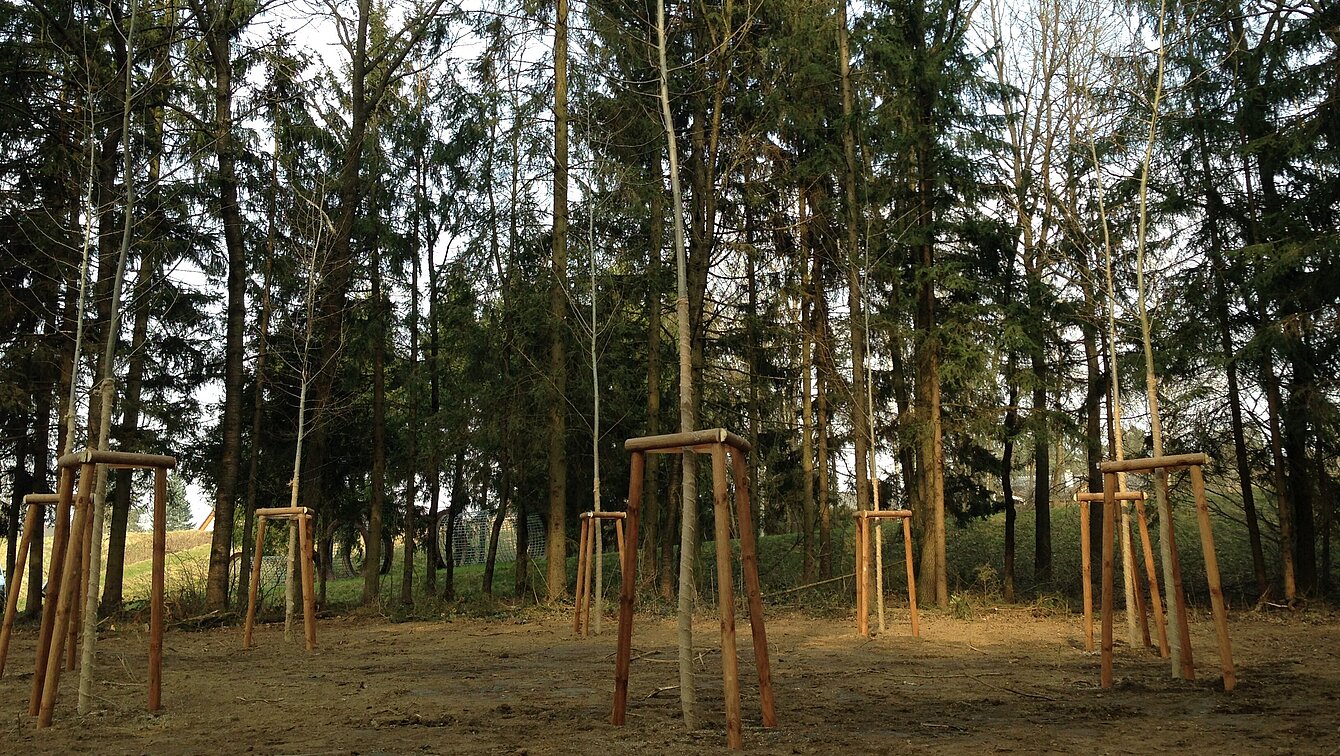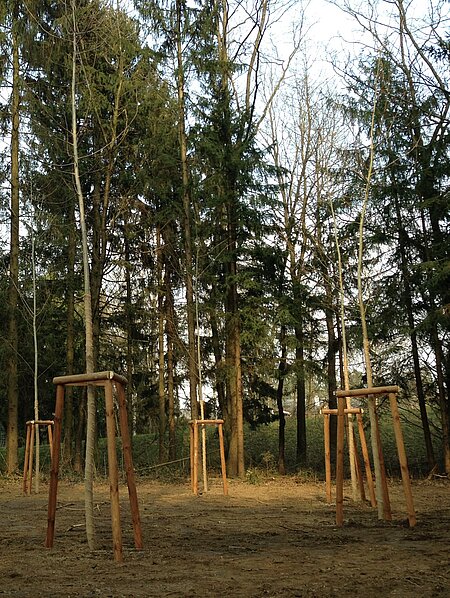Every tree species has its own sound. The sound of the aspen is particularly fine, and can be heard with the slightest breath of air. This is due to the long-stemmed leaves, which strike each other quickly and softly in free twisting movements. In March 2015, a circular grove was cleared in a wooded area of the park, and eight young aspen trees were planted in the architectural layout of an octagon. Over the years, their crowns will close into a dome-like form, allowing visitors to experience the interior of the aspen dome as a listening space.
Aspen Dome
Bernhard Leitner, 2015


Image Credits
Author
Elisabeth Fiedler
Location on map
Position 71
Owner
Österreichischer Skulpturenpark
Artist biography
Bernhard Leitner
Show all
About the sculpture
In addition to precisely calculated pyramidal elevations, artificial paths, water-lily and lotus blossom ponds or areas making differentiated references to historical garden concepts, the garden architecture concept specially developed by Dieter Kienast for the grounds of the Austrian Sculpture Park also features areas that have been left as they have grown randomly. To discover Bernhard Leitner’s sculpture, we must enter one of these woody areas. Consisting of eight aspens planted in the form of an octagon measuring ten metres in diameter, this work grows over the years, ultimately evolving into a walk-in dome open at the top. For the first time, Bernhard Leitner has developed a sound-space sculpture that arises directly out of and in its surroundings.
Important contexts such as bodily structures and their references to nature, perception and reflection, architecture, light, time, sound, speed and motion are themes within which Bernhard Leitner spans out his work.
While his studies of architecture serve as a basis for three-dimensional conception and development of his specific spaces, the intermeshing of architecture, sculpture, graphic design, sound, choreography and new media with physical experience and perception eludes any clear-cut categorisations. Significantly, he was a teacher at the University of Applied Art in Vienna for almost two decades (Institute of Media Art, Cross-Media Art class).
Leitner’s understanding of the mutual contingency and unity of body, dimension and motion arises from his study of critical Viennese modernism, with Karl Kraus, Adolf Loos or Ludwig Wittgenstein, and the new music of Karlheinz Stockhausen, Luigi Nono, Mauricio Kargel, Morton Feldmann, Edgar Varese, John Cage or Jannis Xenakis.
Exploring conceptual and minimal art, he came across works by Richard Serra, Donald Judd or Carl Andre during his time in New York. Of equal interest are new forms of dance with Lucinda Childs, but also the classical ballet of George Balanchine or works of Merce Cunningham and the compositions of John Cage, whose art represents a consistent rejection of the struggle for expression, beginning to understand sound itself as a medium that may be shaped in space. Body art, performance, happening and actionism illustrate how three-dimensionality can be felt and expressed through the body.
Leitner deduced an understanding whereby the human being as a whole acts as a device for hearing and as a resonating body. By using and incorporating sound and tone, he thus creates spaces and sculptures that, on the one hand, open up and overcome boundaries, but deliberately set up boundaries, on the other. The result is an interplay of inside and out, that takes aspects of time, space and body into consideration.
With Aspen Dome for the Austrian Sculpture Park, Bernhard Leitner is adding an architectural octagonal form to his conceptual work, at the same time limiting himself by his choice of site and means to eight trees, that he does not majestically place with a monumental gesture, but rather integrates into an existing woody area. We enter a newly evolving space that is constructed without any technical aids or amplifications, on the one hand delimited, on the other open and accessible at all times. It permits ever new variations of hearing, its sound coming into being regardless of our presence or absence.
Bernhard Leitner makes a clear distinction between incidental hearing and intent listening, consciously engaging and taking in sound in and through the body, whose penetration can be perceived here acousto-haptically in an intimate combination of seeing, hearing and feeling. He leads us to what is in each case a unique experience of space in the here and now. Changes ensue from the varying experiences, influenced not only by climate influences or seasonal differences, but also by differentiated bodily conditions: “The acoustic world is equally a haptic world, which is often overlooked due to our equating hearing and the ear. […] Acoustic haptics plays a key role in my work. The ear is a marvel, but we also hear with our skin, bones, bone tubes, the plates of the bone structure, the membranes, cavities and channels.” (Bernhard Leitner: “Mit dem Knie höre ich besser als mit der Wade”. Über Ton-Raum-Architekturen im Kopf, im Körper und anderswo. Stefan Fricke im Gespräch mit Bernhard Leitner, in: P.U.L.S.E., Bernhard Leitner/ Räume der Zeit/ ZKM 1998, p. 175)
So not only are we integrated into Bernhard Leitner’s work, we act as a kind of instrument and agent, instead of merely listening or viewing in the passive sense: “I want the brain to think in terms of tone and space, I want it to be able to and to want to hear spaces.” (Bernhard Leitner in the lecture Landschaft hören on 10/6/2015 at Kunsthaus Graz, during his stay as artist in residence at the Austrian Sculpture Park.)
The artist is interested in feeling his way through space and in the variability of space. Acoustic space is not static, it comes and goes, with time being the important parameter and the course of events, that cannot be controlled, is to be understood as having no beginning or end. Light, temperature and humidity play as important a role as our physical condition; in the morning, for example, we hear differently to in the evening or we have different sensitivities.
Knowledge of these conditions, based among other things on detailed acoustic and architectural studies in the 17th and 18th centuries, was influenced by Athanasius Kircher, among others. Kircher not only included the four elements water, fire, air and earth in his observations, but also occupied himself with ideas pertaining to nature and acoustics, including those of Augustine, Pythagoras or Seneca, to formulate his own discoveries: “In Sicily at Mount Etna, when the Euronotus blows/ a constant harmonious sound is heard/ no different/ than when one would hear several strings tuned to the 5th, 3rd and 8th. The author just observed this in the trees of different size/ when they were moved by the wind/ when one tree is twice the size of another/ for example the cypress and the poplar…” (Kircherus Jesuita Germanus Germaniae redonutas: sive Artis Magnae de Consono & Dißono Ars Minor; Das ist: Philosophischer Extract und Auszug, aus deß Welt-berühmten Teutschen Jesuitens Athanasii Kircheri von Fulda Musurgia Universali. Authors: Athanasius Kircher, Andreas Hirsch, Verlag Gräter 1662. Original: Bayrische Staatsbibliothek; digitalised on 19 Oct. 2012, p. 265).
With Aspen Dome, Bernhard Leitner not only recalls this almost forgotten analysis, he consistently reduces its authorship to the special constellation of specific trees in a specific setting. He draws for this purpose on an existing vocabulary of form, with the aid of which he reinstalls rooted, mutable and ephemeral aspects, allowing us to experience them, recalling comprehensive perception and making us conscious of vertical hearing – “inward listening”, explaining quite simply:
“Every tree has its own sound. The aspen (Populus tremula) has a particularly fine sound, that can be heard in the slightest movement of air. It is the long-stemmed leaves that strike each other quickly and softly in their free rotational movements. In March 2015 a circular grove was cleared in a piece of woodland in which eight young aspens were planted in an octagonal layout. In around three years’ time, their tops will close to form a dome-like form and allow visitors to experience the interior of the aspen dome as a space of hearing.”



















